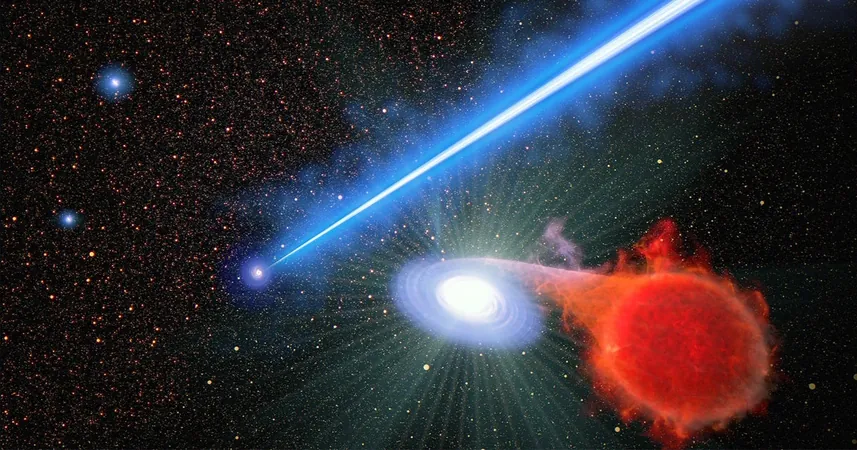
Scientists Discover Explosive Effects of Black Hole Jets on Nearby Stars!
2024-10-01
Introduction
Black holes, the enigmatic giants of our universe, continue to astonish scientists with their unpredictable behavior. New research led by astronomers using the Hubble Space Telescope has revealed that a colossal black hole located in the galaxy M87 is not just sucking in matter but is actively shooting out powerful jets of energy that trigger explosive activity among nearby stars.
The Colossal Black Hole in M87
Nestled at the heart of M87, this supermassive black hole boasts a mind-boggling mass that is 6.5 billion times that of our Sun. Its jets, composed of plasma propelled at nearly the speed of light, stretch out for an astonishing 3,000 light-years. Researchers are particularly intrigued by these jets because they appear to be responsible for initiating nova eruptions in binary star systems located in their vicinity.
Groundbreaking Study Findings
In a groundbreaking study published in The Astrophysical Journal, the research team discovered that the number of novas erupting along the path of this black hole’s jets is significantly higher—double, in fact—than in other regions of the galaxy. For context, novas are relatively common cosmic events. In M87 alone, it's believed that there’s a nova eruption occurring every day, and the entire observable universe sees about a million novas erupting every second!
Expert Insights
Alec Lessing, the lead author of the study from Stanford University, emphasized the excitement surrounding these findings: “We don't know what's going on, but it's just a very exciting finding. This means there's something missing from our understanding of how black hole jets interact with their surroundings.”
Understanding Novas
But what exactly causes this remarkable phenomenon? Typically, a nova is characterized by repeated explosions in a binary system, where a normal star nearing the end of its life cycle, known as a red giant, is paired with a white dwarf—a dense remnant of a star. When the red giant sheds material, its mass is pulled toward the white dwarf, leading to nuclear detonations on its surface.
The Role of Black Hole Jets
The research points to several intriguing possibilities regarding how the black hole jets could be accelerating these novas. One hypothesis is that the jets may be 'snowplowing' hydrogen gas into the surroundings, thereby increasing the rate at which material falls onto the white dwarfs. Lessing suggested, "When you deliver hydrogen faster, you get eruptions faster. This could explain why we see more frequent novas in areas near the black hole jet."
Further Implications
Additionally, it's possible that the energy from the jet could be heating the red giant stars, enhancing their material loss and contributing to more frequent eruptions on the white dwarfs. However, the precise mechanisms remain elusive, indicating that further observations and studies will be necessary to unlock the secrets of these cosmic interactions.
Conclusion
The implications of these findings extend beyond just understanding black holes; they challenge our current knowledge of stellar evolution and interactions. As researchers delve deeper into the universe's mysteries, they may uncover more about the dynamic dance of destruction and creation that occurs in galaxies far away.
Final Thoughts
For those star lovers out there, the universe never ceases to amaze—the next discovery could be waiting just around the cosmic corner!


 Brasil (PT)
Brasil (PT)
 Canada (EN)
Canada (EN)
 Chile (ES)
Chile (ES)
 España (ES)
España (ES)
 France (FR)
France (FR)
 Hong Kong (EN)
Hong Kong (EN)
 Italia (IT)
Italia (IT)
 日本 (JA)
日本 (JA)
 Magyarország (HU)
Magyarország (HU)
 Norge (NO)
Norge (NO)
 Polska (PL)
Polska (PL)
 Schweiz (DE)
Schweiz (DE)
 Singapore (EN)
Singapore (EN)
 Sverige (SV)
Sverige (SV)
 Suomi (FI)
Suomi (FI)
 Türkiye (TR)
Türkiye (TR)